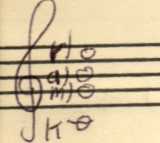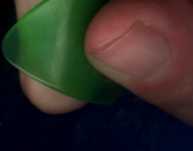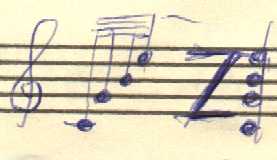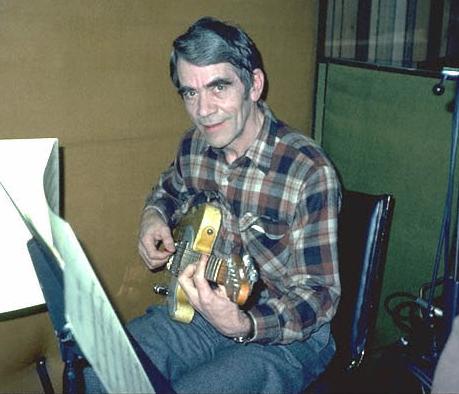Canada's unparalleled electric guitar master, Edward Issac
Bickert was born November 29,1932 in the Mennonite-strong
prairie town, of Hochfield Manitoba, Canada. The youngest
sibling in a brood of 2 sons and 3 daughters, the infant Eddie's
parents moved the family to the Okanagan Valley of British
Columbia, soon afterward. The Bickert family ended up farming
outside Vernon B.C., in the Valley's rich orchard region.
(I believe the foundation of Bickert's "plucking" came from his
boyhood years working in the trees!)
Ed's fiddler father ,and pianist mother raised their children
with plenty of music. His sisters all sang the pop hits of the
day. The older brother played chord style guitar and it was on
a Dobro model tuned standard, without the raised bridge, and
slide, it seems, that Ed was to pick up along the way and learn
to play at age 8.
(see PLAYING IT SAFE by Jack Batten, The Canadian magazine Dec
31, 1978)
Ed Bickert refers to the chord fingerings that his brother
showed him, as grips.
In the Thirties and Forties, far from the "media frenzy" of
musical styles, the Bickert parents played a mixture of social
country music at local weekend dances which the youngest child
joined them in, playing "polkas, Viennese waltz-type things
foxtrots, one-steps,two-steps and schottisches" (to Mark Miller
Guitar Player magazine Sept 1978). If the precocious Eddie
ventured a variation on the harmonies , his father might gently
reprove him. It was a "real Dogpatch scene" according to an
older Ed Bickert. The people were dancing and wanted nothing more
than a good beat to the changes, nothing fancy. Playing these
tunes was formative though, as the young musician learned the
importance of a steady tempo.
The Bickert family loved radio ,and several current American
perfomers were a respite from the indigenous Okanagan musical
recipe. Ellington, Armstrong, Basie and others were favourites
of Ed Bickert's father. The singing cowboy movies of the time
all added to the influence on the teenaged Ed. Equally, Nat
King Cole's classic Trio (with guitarist Oscar Moore and later
Irving Ashby), and the inimitable Les Paul, gave Ed Bickert a
wider view of music and guitar playing. He had missed the
direct influence of Charley Christian, who affected so many
American jazz guitarists of his generation. Local bands passing
through the Western provinces had some impressive guitarists.
Ed would benefit from hearing these men play, as in the case of
Gordie Brandt, they might be a more adventurous soloist, contrasted
to Ed's "laidback" nature.
Other playing experiences introduced Bickert to rugged
pickup /amplification. On acoustic guitar precarious feedback
devils would frequently give a "start" to a solo.
Listening to a long-range broadcast of a San Francisco area
jazz show also contributed to his modern jazz ears, out there
in the middle of British Columbia, east of the Pacific coast.
After high school, Ed worked long enough to get a itch to go
east to Toronto, Ontario, and see how the city would welcome a
talented musician. With a writer friend, and a 3/4 size bass ,
Bickert drove an old '30's car eastward across Canada, turning
south to go through Chicago and Detroit, since the Trans-Canada
Highway was still under construction, in 1952.
He took a job at a radio station, briefly, as an engineer,
while he checked out Toronto's live music scene, which was
intimidating at first, the guitar players in particular. He
bided his time, studied formally with Tony Braden a respected
teacher to many generations of Toronto area guitarists, who
guided Bickert through some fundamental approaches to scales,
shifting, and went on to Stan Wilson for re-direction in his
flatpicking. |
Shifting positions on the guitar offers different ranges of
scales in the same key, and harmonic modulations for altered
chords taken outside that scale selection.
Example of one key, from many positons C Major:
http://ca.geocities.com/strumdabiz/fret/C/c_array1_12.html
|
Regarding chords (e.g Re:)
A]Chords on the other hand, or the same hand as it happens, can
be practically voiced with different string sets for 2-3-4(or
5) voicings, triads and advanced harmonies alike often having 2-
to 4-string combinations and the last, practicly, in at least
two octaves of range.
B] Omitting principle chord tones like roots and/or fifths gains
much more possiblity, when there is a bassist playing those
fundamentals, guitar actually raising those pitches up a whole
step (2 frets, or a third (4 frets, to start, adds colour.
C] The Major(M) .. or .. Flat (b) 7ths change the colours, for the
partials 9ths* (b, Major, or #) and an additional6ths,
or 13ths, as below **,
dump the triad's staidness, entirely.
Observe = (o7o)
~` Re : A] 'Re: B] M $ '** `~
E|----C/E---------|-CMaj7&9-C9----|Z5+-Z5+-Z5+-Z5+-|E
B|Z1=(C)==--------|Z3++-----Z3++--|Z3+-Z2+-Z3+-Z4+-|B
G|Z0=(G) \_Z5++++|Z4++-----Z3++--|Z4..Z3+-Z3+-Z3+-|G
D|Z2=(E) \_Z5++++|Z2++-----Z2++--|Z2+-Z2+-Z2+-Z2+-|D
A|(k3)-\==\_Z7++++|-(k3)----------|----------------|A
E|,---,---,--(K8)-|,---,---,---,--|,---,---,---,---|E
~` ' (o7o) (o7o) ' `~
=====================================================
Three different fingering (grips) of C Major 7th with same
pitchs C_G_B_E from root in bass.
 E|r0++++++|,-,-,-,-|-------|E
B|a0++++++|r5++++++|=======|B
G|m0++++++|a+++++++|r9+++++|G
D|========|m5++++++|a9+++++|D
A|K3++++++|K3++++++|m10++++|A
E|,-,-,-,-|========|K10++++|E
E|r0++++++|,-,-,-,-|-------|E
B|a0++++++|r5++++++|=======|B
G|m0++++++|a+++++++|r9+++++|G
D|========|m5++++++|a9+++++|D
A|K3++++++|K3++++++|m10++++|A
E|,-,-,-,-|========|K10++++|E
|
Some gigs in small groups, playing "shmaltzy" type music for
older people in restaurants, weren't as creative as Bickert may
have wished, but paid the bills and got him in the "biz".
Eventually, Bickert was to say hello to the inventive Tal Farlow
who stepped into an after-hours club where Ed was playing. Imagine!
They played guitar until sunrise, the next morning.
Jamming with this other, more fleet-fingered, American country
boy earned Ed hyperbolic praise, from one local scribe. From
there, Bickert found his own distinct talent had a place
amongst the likes of a new generation of Toronto's professional
musicians.
The House Of Hambourg, where Bickert made a mark in the town's
music community was for these musicians a common ground in the
1950's.
From the better known American guitarists, Johnny Smith and
George Van Eps impressed him for their deft approaches and he's
studied from books by both. Bickert listened to recordings by
the likes of Farlow, Burrell, Kessel, Hall, and others during
these years, but made an effort to be his own man on the jobs
he played, and eventually drew his chordal inspirations from
pianists as much as anybody.
The late Moe Koffman, and others came to appreciate the quiet
natured Bickert's ear, and musical sense of balance. Various
playing situations such as the late Ron Collier's, Norm
Symonds' arrangements would challenge Bickert's skills on two levels:
1)Sightreading music notation, or alpha-numbero charts, to
begin with. There's no time for session players to "hear it
first". The page is boss.
2) Learning something other than alternate strumming strokes
was a departure from the way he generally "attacked" chords. |
Technically ? (by Sandy Freeze)
A] Classical guitarists have designated p i m a for attack.
p)___i)______m)______a)____
______________|thumb, index, medio, annul |________________-
fingers of the Right hand for various combinations.

K\/k
  B] A guitarist who flatpicks, usually holds the pick
K\ with (p) and (i) finger.
B] A guitarist who flatpicks, usually holds the pick
K\ with (p) and (i) finger.
  ......
......
 ...... ...... ......
That leaves 1, 2...Wait!. 3 fingers! (look careful)
C]I've added K\/k to indicate alternate \/picking strokes here.
Then naming the little (4th) finger , pinky=red= r)...
/roll ,right...Ralph?\
D] Hence: K\/k__r)a)m_ Pick and roll : The word hybrid is often
linked to this method , which various styles and stylists in
music employ to equally unique ends.
......
That leaves 1, 2...Wait!. 3 fingers! (look careful)
C]I've added K\/k to indicate alternate \/picking strokes here.
Then naming the little (4th) finger , pinky=red= r)...
/roll ,right...Ralph?\
D] Hence: K\/k__r)a)m_ Pick and roll : The word hybrid is often
linked to this method , which various styles and stylists in
music employ to equally unique ends.
|
Ed Bickert needed 3 and 4 voices. So he adapted naturally.
He learned to play the unique "arranger" voicings with his
own "half-baked" combination of flatpicking and plucking with
the remaining three fingers K\/k_r)a)m).
 This is a way of bringing out the few notes of the guitar chord
fluidly, but simultaneously. In solely pick strummed (Z) chords,
voices are minutely separate however acute the attack is.
PicK and "roll" K_r)a)m)is a way of articulate (tutti) attack.
Accurate, and fluid arpeggios can "thaw" out of these same
voicings, or grips, to any rythymnic and musical effect.
This is a way of bringing out the few notes of the guitar chord
fluidly, but simultaneously. In solely pick strummed (Z) chords,
voices are minutely separate however acute the attack is.
PicK and "roll" K_r)a)m)is a way of articulate (tutti) attack.
Accurate, and fluid arpeggios can "thaw" out of these same
voicings, or grips, to any rythymnic and musical effect.
|
|
| ___________example: C Major 7th ____________ |
    |
Subtly?
~ Z = \\\\: VERSUS tutti OR Arpeggio`~
E|;---=: :|_______|::::|^^^^^|1/8ths..|E
B|Z5++=---K5|_______|r5++|.....|------r5|B
G|Z4++=--K4+|_______|a4++|.....|----a4++|G
D|Z5++=-K5++|_______|m4++|.....|--m5++++|D
A|Z3++=K3+++|_______|K3++|.....|K3++++++|A
E|----------|_______|,---|^^^^^|,---,---|E
~`C Major7th' ' ' ' `~
| .......
Remember those chord variations, though, that a younger Eddie
would try? Chances are, the more imaginative voicings found a
place in this world of piano and horns. Bickert was listening to
recordings by the likes of Ellington (and could claim a
recording with the Duke in later years under Collier's baton),
and people like Gil Evans whose work was revolutionary .
A hit tune "Swinging Sheperd's Blues" by fluteist
Moe Koffman, may be the most obvious early example
of the 25-year old Bickert's smooth guitar style,
before smooth was a dirty word, at least?
The pick and pluck attack, that would give Bickert his
characteristic sound, was born out of the need to bring these
chords out with a kind of pianistic block voicing. This made Ed
Bickert a distinct musician and guitarist.
|
NOTE on TONES.
One particular aspect which Bickert came to, is the combination
of voicings which, like many vocal groups are re-knowned for,
is the ghost note arising from harmonic resonances between
sounded stops. I am reminded of The Mamas and Papas calling such
a note "Harvey", a` la the rabbit in the eponymously titled
Jimmy Stewart movie.
Ironically it's just what you leave out that leaves room for
such magic to happen.
One contemporary of Bickert's, the 9-years-younger guitarist
Lenny Breau, made an impression on Ed, with his own advanced
harmonic chordal approach, and Bickert has acknowledged this.
http://www.guitarchives.com/lenny.htm
Born in Auburn Maine, to country and Western entertainers
Hal "Lone" Pine and his wife Betty Cody, the phenomenal Breau's
investigation of many styles, from imitating Les Paul's and
Chet Atkins', to traditional jazz, in Bickert's birth-province,
Manitoba, in its country music circuit, where they moved to in
the fifties.
[A second common point, between Bickert and Breau is B.C.-born
musician Don Thompson, bassist, pianist , vibist, and drummer.
He had played with each of these guitarists.]
Using a thumb pick, and all four right hand fingers to attack
the strings he employed a variety of American styles, and even
flamenco, to play whole self-accompanied passages. Breau's near
savant-like daily obsession, with the guitar, led to a nearly
un-paralleled mastery of a classical technique of bringing
out distinct overtones, from what amounts to:
...right-hand fingers lightly touching the strings at
distinct points (x) between string-stops (#) and the bridge of
the guitar, in bell-like tones, 'o': "harmonics" giving octave
5ths , 10ths or other partials.
#++----(x'o')
* right finger...
Bickert does not, for the most part, employ this extended
right hand technique, except for the odd finish. But, Breau's
thorough ability to voice Bill Evans-type chords, themselves,
in grips from different inversions, and superpositions of notes
or triads, was right up Bickert's "alley" of grips. (Breau may
have even studied with Evans, a bit.)
Breau used a 7-string guitar with the additional string tuned
to A=440hz, not unlike a tenor banjo's top string.
[George Van Eps pioneered 7-string, but with a low 'A' string.]
Having heard, and seen Lenny Breau, myself, one Valentines's
Day in the 70's, I'd add to my original comment on Part I, i.e.
Part I: Ed Bickert Guitar Workshop
regarding Breau's right hand technique, that I've been very
fortunate to hear such talent.
|
|

 ______________
______________
 ______________
______________
 E|r0++++++|,-,-,-,-|-------|E
B|a0++++++|r5++++++|=======|B
G|m0++++++|a+++++++|r9+++++|G
D|========|m5++++++|a9+++++|D
A|K3++++++|K3++++++|m10++++|A
E|,-,-,-,-|========|K10++++|E
E|r0++++++|,-,-,-,-|-------|E
B|a0++++++|r5++++++|=======|B
G|m0++++++|a+++++++|r9+++++|G
D|========|m5++++++|a9+++++|D
A|K3++++++|K3++++++|m10++++|A
E|,-,-,-,-|========|K10++++|E




 ......
......
 ......
...... ......
That leaves 1, 2...Wait!. 3 fingers! (look careful)
......
That leaves 1, 2...Wait!. 3 fingers! (look careful)
